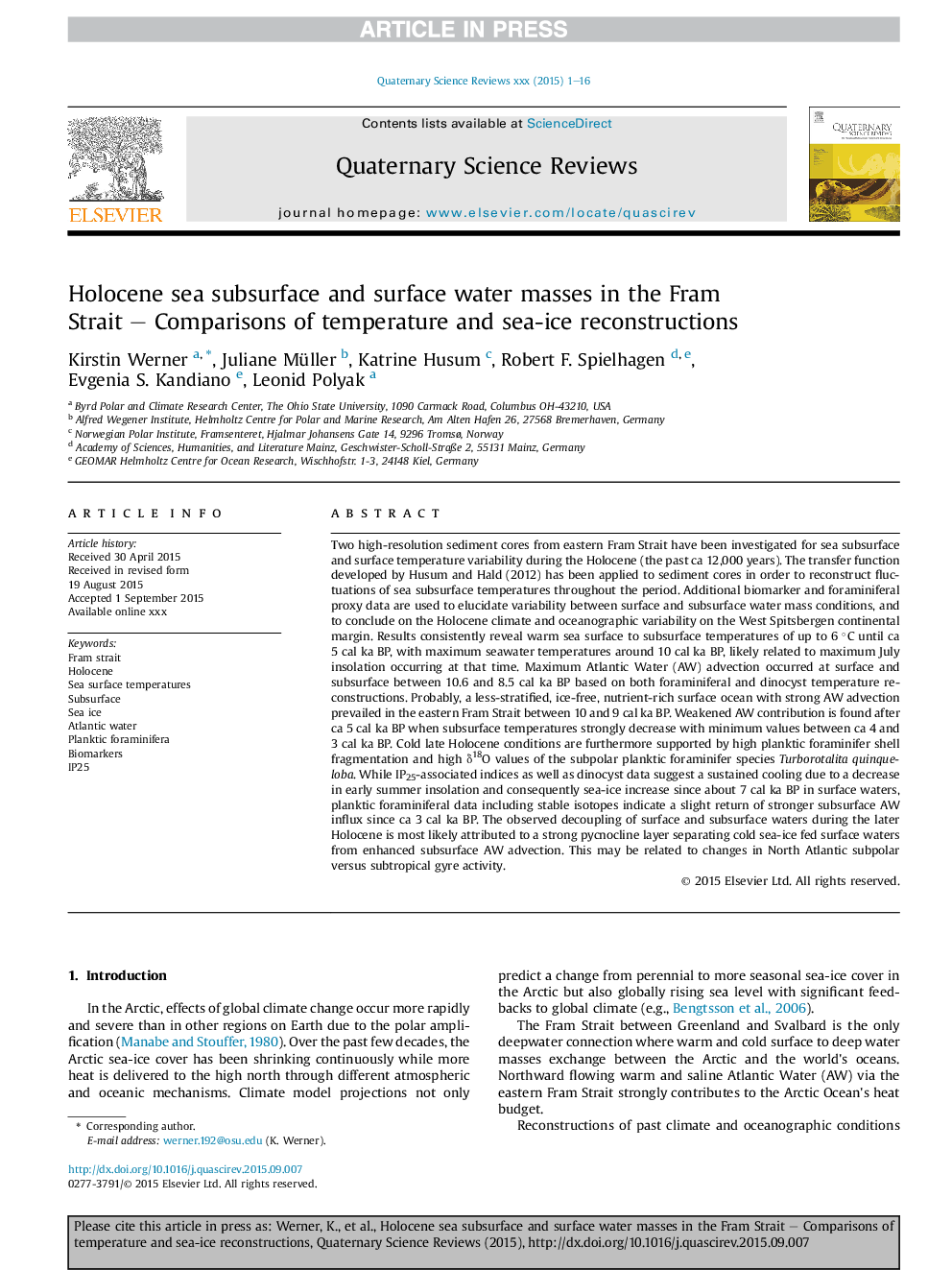| کد مقاله | کد نشریه | سال انتشار | مقاله انگلیسی | نسخه تمام متن |
|---|---|---|---|---|
| 6446457 | 1640788 | 2016 | 16 صفحه PDF | دانلود رایگان |
عنوان انگلیسی مقاله ISI
Holocene sea subsurface and surface water masses in the Fram Strait - Comparisons of temperature and sea-ice reconstructions
ترجمه فارسی عنوان
مقیاس های دما و بازسازی یخچال های دریایی
دانلود مقاله + سفارش ترجمه
دانلود مقاله ISI انگلیسی
رایگان برای ایرانیان
کلمات کلیدی
موضوعات مرتبط
مهندسی و علوم پایه
علوم زمین و سیارات
زمین شناسی
چکیده انگلیسی
Two high-resolution sediment cores from eastern Fram Strait have been investigated for sea subsurface and surface temperature variability during the Holocene (the past ca 12,000 years). The transfer function developed by Husum and Hald (2012) has been applied to sediment cores in order to reconstruct fluctuations of sea subsurface temperatures throughout the period. Additional biomarker and foraminiferal proxy data are used to elucidate variability between surface and subsurface water mass conditions, and to conclude on the Holocene climate and oceanographic variability on the West Spitsbergen continental margin. Results consistently reveal warm sea surface to subsurface temperatures of up to 6 °C until ca 5 cal ka BP, with maximum seawater temperatures around 10 cal ka BP, likely related to maximum July insolation occurring at that time. Maximum Atlantic Water (AW) advection occurred at surface and subsurface between 10.6 and 8.5 cal ka BP based on both foraminiferal and dinocyst temperature reconstructions. Probably, a less-stratified, ice-free, nutrient-rich surface ocean with strong AW advection prevailed in the eastern Fram Strait between 10 and 9 cal ka BP. Weakened AW contribution is found after ca 5 cal ka BP when subsurface temperatures strongly decrease with minimum values between ca 4 and 3 cal ka BP. Cold late Holocene conditions are furthermore supported by high planktic foraminifer shell fragmentation and high δ18O values of the subpolar planktic foraminifer species Turborotalita quinqueloba. While IP25-associated indices as well as dinocyst data suggest a sustained cooling due to a decrease in early summer insolation and consequently sea-ice increase since about 7 cal ka BP in surface waters, planktic foraminiferal data including stable isotopes indicate a slight return of stronger subsurface AW influx since ca 3 cal ka BP. The observed decoupling of surface and subsurface waters during the later Holocene is most likely attributed to a strong pycnocline layer separating cold sea-ice fed surface waters from enhanced subsurface AW advection. This may be related to changes in North Atlantic subpolar versus subtropical gyre activity.
ناشر
Database: Elsevier - ScienceDirect (ساینس دایرکت)
Journal: Quaternary Science Reviews - Volume 147, 1 September 2016, Pages 194-209
Journal: Quaternary Science Reviews - Volume 147, 1 September 2016, Pages 194-209
نویسندگان
Kirstin Werner, Juliane Müller, Katrine Husum, Robert F. Spielhagen, Evgenia S. Kandiano, Leonid Polyak,
